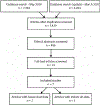Human exposure pathways to poly- and perfluoroalkyl substances (PFAS) from indoor media: A systematic review
- PMID: 35240384
- PMCID: PMC11577573
- DOI: 10.1016/j.envint.2022.107149
Human exposure pathways to poly- and perfluoroalkyl substances (PFAS) from indoor media: A systematic review
Abstract
Background: Human exposure to per- and polyfluoroalkyl substances (PFAS) has been primarily attributed to contaminated food and drinking water. There is information indicating other sources and pathways of exposure in residential environments, but few studies report relationships between these indoor media and human biomonitoring measurements.
Methods: This study adapts existing systematic review tools and methodologies to synthesize evidence for PFAS exposure pathways from indoor environment media including consumer products, household articles, cleaning products, personal care products, and indoor air and dust. Studies were identified using innovative machine learning approaches and pathway-specific search strings to reduce time needed for literature search and screening. The included studies and systematic review were evaluated using tools modified specifically for exposure studies. The systematic review was conducted following a previously published protocol (DeLuca et al., 2021) that describes the systematic review methodology used in detail.
Results: Only 7 studies were identified that measured the targeted subset of 8 PFAS chemicals in concordant household media (primarily house dust) and participant serum. Data extracted from the included studies were used to calculate exposure intake rates and estimate a percentage of occupant serum concentrations that could be attributed to the indoor exposure pathways. These calculations showed that exposure to PFOA, PFOS, PFNA, and PFHxS from contaminated house dust could account for 13%, 3%, 7%, and 25% of serum concentrations, respectively. Inhalation of PFAS in indoor air could account for less than 4% of serum PFOA concentrations and less than 2% of serum PFOS and PFNA concentrations. A risk of bias was identified due to participant profiles in most of the studies being skewed towards white, female, and higher socioeconomic status.
Conclusions: Along with synthesizing evidence for estimated contributions to serum PFAS levels from indoor exposure media, this systematic review also identifies a consistent risk of bias across exposure study populations that should be considered in future studies. It highlights a major research gap and need for studies that measure concordant data from both indoor exposure media and participant serum and the need for continued research on exposure modeling parameters for many PFAS chemicals.
Published by Elsevier Ltd.
Conflict of interest statement
Declaration of Competing Interest
The authors declare that they have no known competing financial interests or personal relationships that could have appeared to influence the work reported in this paper.
Figures




Similar articles
-
Human exposure pathways to poly- and perfluoroalkyl substances (PFAS) from indoor media: A systematic review protocol.Environ Int. 2021 Jan;146:106308. doi: 10.1016/j.envint.2020.106308. Epub 2020 Dec 11. Environ Int. 2021. PMID: 33395950 Free PMC article.
-
Systematic Evidence Mapping of Potential Exposure Pathways for Per- and Polyfluoroalkyl Substances Based on Measured Occurrence in Multiple Media.Environ Sci Technol. 2023 Apr 4;57(13):5107-5116. doi: 10.1021/acs.est.2c07185. Epub 2023 Mar 20. Environ Sci Technol. 2023. PMID: 36940151 Free PMC article. Review.
-
Understanding prenatal household exposures to per- and polyfluorylalkyl substances using paired Biological and dust measurements with sociodemographic and housing variables.Environ Int. 2024 Dec;194:109157. doi: 10.1016/j.envint.2024.109157. Epub 2024 Nov 16. Environ Int. 2024. PMID: 39642652
-
Characteristic and human exposure risk assessment of per- and polyfluoroalkyl substances: A study based on indoor dust and drinking water in China.Environ Pollut. 2019 Nov;254(Pt A):112873. doi: 10.1016/j.envpol.2019.07.041. Epub 2019 Jul 18. Environ Pollut. 2019. PMID: 31369910
-
Systematic evidence mapping of potential correlates of exposure for per- and poly-fluoroalkyl substances (PFAS) based on measured occurrence in biomatrices and surveys of dietary consumption and product use.Int J Hyg Environ Health. 2024 Jun;259:114384. doi: 10.1016/j.ijheh.2024.114384. Epub 2024 May 11. Int J Hyg Environ Health. 2024. PMID: 38735219 Free PMC article. Review.
Cited by
-
Serum per- and polyfluoroalkyl substance concentrations and longitudinal change in post-infection and post-vaccination SARS-CoV-2 antibodies.Environ Res. 2023 Dec 15;239(Pt 1):117297. doi: 10.1016/j.envres.2023.117297. Epub 2023 Oct 8. Environ Res. 2023. PMID: 37816422 Free PMC article.
-
Exposure to per- and polyfluoroalkyl substances (PFAS) in North Carolina homes: results from the indoor PFAS assessment (IPA) campaign.Environ Sci Process Impacts. 2025 Jun 18;27(6):1654-1670. doi: 10.1039/d4em00525b. Environ Sci Process Impacts. 2025. PMID: 39526893
-
Environmental public health research at the U.S. Environmental Protection Agency: A blueprint for exposure science in a connected world.J Expo Sci Environ Epidemiol. 2025 Jul;35(4):539-547. doi: 10.1038/s41370-024-00720-8. Epub 2024 Nov 16. J Expo Sci Environ Epidemiol. 2025. PMID: 39550492 Free PMC article. Review.
-
Emerging Per- and Polyfluoroalkyl Substances in Tap Water from the American Healthy Homes Survey II.Environ Sci Technol. 2025 Feb 11;59(5):2686-2698. doi: 10.1021/acs.est.4c08037. Epub 2025 Jan 29. Environ Sci Technol. 2025. PMID: 39878442 Free PMC article.
-
Unregulated and Regulated PFASs in Bottled and Tap Water: Occurrence, Co-Occurrence Patterns, and Implications for Human Health and Regulatory Frameworks.J Xenobiot. 2025 May 27;15(3):81. doi: 10.3390/jox15030081. J Xenobiot. 2025. PMID: 40558864 Free PMC article.
References
-
- Balk FGP, Winkens Pütz K, Ribbenstedt A, Gomis MI, Filipovic M, Cousins IT, 2019. Children’s exposure to perfluoroalkyl acids–a modelling approach. Environ. Sci. Processes Impacts 21 (11), 1875–1886. - PubMed
-
- Bartolomé M, Gallego-Picó A, Cutanda F, Huetos O, Esteban M, Pérez-Gómez B, Castaño A, 2017. Perfluorinated alkyl substances in Spanish adults: geographical distribution and determinants of exposure. Sci. Total Environ. 603–604, 352–360. - PubMed
-
- Beesoon S, Genuis SJ, Benskin JP, Martin JW, 2012. Exceptionally high serum concentrations of perfluorohexanesulfonate in a Canadian family are linked to home carpet treatment applications. Environ. Sci. Technol. 46 (23), 12960–12967. - PubMed
Publication types
MeSH terms
Substances
Grants and funding
LinkOut - more resources
Full Text Sources
Medical
Miscellaneous

